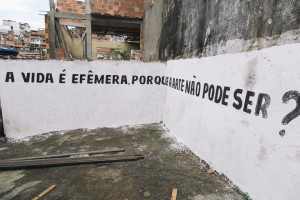3rd Bahia Biennale
É Tudo Nordeste? (Is Everything Northeast?)
May 29–September 7, 2014
Chief Curators: Marcelo Rezende, Ana Pato and Ayrson Heráclito
Co-Curators: Fernando Oliva and Alejandra Muñoz
About Bahia Biennale
Closing a gap of 46 years since the last edition was closed by the military regime, the state of Bahia has resumed its Biennale of visual arts as a continuity of the 1966 and 1968 editions. It brings back the intentions of the original project: establishing a counter-discourse that is suitable for creating, promoting and establishing alternative routes in the art field, without the need to depend on legitimation from other national and international centres. The Biennale also updates the original project to the current Brazilian and international contexts, where the concepts of center and periphery are being redefined.
Following the question that permeates the curatorial project, É Tudo Nordeste? (Is Everything Northeast?), the Bahia Biennale breaks out of the Bahia Museum of Modern Art (MAM-BA) spreading its actions over more than 30 public and private spaces in the capital, Salvador, and a dozen other cities in the state of Bahia. Churches, universities, cultural centres, libraries, Candomblé temples, schools and ateliers host exhibitions, workshops and artistic occupations, offering not only a broad range of visiting circuits but also an active dialogue about spaces and the artistic endeavours interacting within them.
Instead of a showcase of contemporary output, the Bahia Biennale presents actual artistic processes interfering in the urban space, including in its scope the poorest neighbourhoods of Salvador throughout partnerships with community associations and local initiatives.
3rd Bahia Biennale – Second Season
In this second season the Bienal expands its action structures and continues the extensive research on a whole generation of Bahia artists working since the 1960s and 1970s whose works have only recently been noticed in the arts circuit. Rogério Duarte, visual guru of Tropicalism; Juarez Paraíso and his cosmic-fiction universe on canvas and other dimensions; the environmental art of pioneer Juraci Dórea; and the psychedelic creations of Dicinho and Edinízio Primo will all be contemplated with comprehensive exhibitions. Borne out of an original research by chief curator Ayrson Heráclito, rare works, previously regarded as long lost, of the PEBA movement, from which some of the most important names of the Brazilian art scene of the last 40 years emerged (e.g Caetano Veloso and Gilberto Gil), will also have their first display since the heyday of the late 1960s/early 1970s.
The Imaginary Museum of the Northeast spreads its occupation of public spaces with exhibition sets designed to offer a critical alternative to the very concept of the museum: as a privileged space to reinvent and reorganize the past in order to tune it to the public. According to chief curator Marcelo Rezende, “we see the Northeast, the cradle of the ‘Brazilian civilization,’ as a place where actions, ideas and objects from all over the world have set foot, and now we collect the pieces of all this history in different spaces, each dedicated to a particular subject.” The I.M.N. brings together artists from different nationalities, such as Charbel-joseph Boutros (Lebanon), the works of Yves Klein or the German writer Arno Schmidt, interacting with the local production and the cultural heritage of Salvador.
Among the main action fields proposed by the 3rd Bahia Biennale, the Archive and Fiction Working Group, curated by Ana Pato, was set to exchange experiences, research and content production about artistic practices and archival procedures. Throughout its workshops, lost archives and collections are being identified and mapped, offering a broad range of materials for commissioned artists to carry out artworks specially designed for the 3rd Biennale. In the second season the results of these works will be displayed in the State Archives, located in a 16th-century building, together with an exhibition of articles unearthed from the police archives—including Candomblé items confiscated throughout decades of repression of the Afro-Brazilian religion as well as mortuary masks and mummified corpses of cangaceiros (country bandits of the 1920s and 1930s).
As a conceptual centrepiece of the Bienal, the Naturalisme Integral of Pierre Restany, Frans Krajcberg and Sepp Baendereck is regaled with a special exhibition dedicated to the pioneers and followers of environmental art.
Image: Exhibition Public Archive. Photo: Alfredo Mascarenhas


